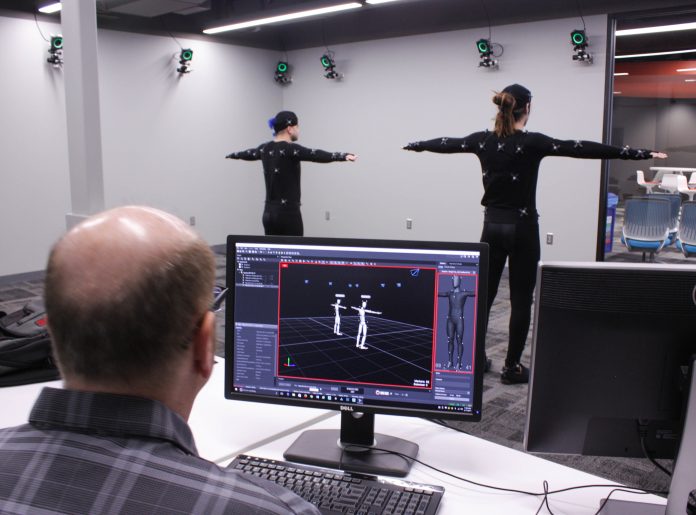
Connor Heaton
Reporting correspondent
Recently, the college received funding for a new cutting-edge piece of equipment designed to improve and expedite the animation process for both students and professionals alike. Located within the CoLab, the motion capture room stands at the ready — armed with over a dozen infrared cameras of pinpoint precision.
Chair of the animation department, Jeffrey Byers, helped garner funding and raised awareness for the technology. The motion capture room is one of the newest additions to the college’s many advanced pieces of equipment.
“Just about when we started classes here is when we got the system,” Byers said. “It’s literally only about 4-5 weeks old. Within that time, Professor Russ Hanna and I wrote up standards that take you through the processes of running the system the right way.”
Byers describes motion capture as “the ability to capture performances from artists whether it be a visual representation of an action or an art form.” When the performers broadcast their actions, the equipment will capture and bring it into a form animators can use later in the computer.
The college uses the OptiTrack motion capture equipment: a cutting-edge tool praised for both its acuteness and versatility. The technology is built upon several layers of complexity. Animators typically use Maya or Unity software to edit their performances. The camera records the motion and sends it to the computer, where the software edits the footage into what people want.
“The reason I was blown away by OptiTrack was that it had zero errors,” Byers said. “That means it will capture at an accuracy of .001 millimeters, which means no jittering or foot sliding. All that’s gone now.”
James Simmons, a character animation major at the college, explains the animation process in-depth.
“It’s fairly complicated,” Simmons said. “I liken it to when you’re building little plastic models. You get a bunch of little pieces and you have to clip them out of that plastic. Likewise, you have a lot of extra animation that you don’t need and have to refine, but it’s much faster than trying to do it [the old fashion way].”
Motion capture is a two-part process that involves the cooperation between animators and actors, fusing the two art-forms into one presentation. The better the actor, the better the animation.
Motion capture actor Sawyer Stone said he wants to bring his talents, which include swordfighting, into the virtual world. Stone has to put on the motion capture equipment: a black, skin-tight suit adorned with dozens of tiny white balls. This suit is designed to help the motion capture software detect various points on the body, allowing more accurate recordings.
“It’s snug but doesn’t feel gross or too tight-fitting, and you don’t even notice the dots,” Stone said. “It only becomes a concern for me when doing rolls or the like since the dots may come off, since they are velcro. Also you start to notice you’re wearing the suit after a bit of physical exertion, as it’ll get hot and itchy after a while.”
There are many applications for this technology as universities start to look into motion capture for athletic and health care professionals.
“You can look at athletes that have been hurt and their line of motion and how they swing,” Byers said. “They can capture these athletes and they can take this data and break it down, they can find what they need to work on. I see this in medical, sports and beyond. It’s everywhere and I’m excited to see what we can do in the future.”
Because of the versatility of motion capture throughout many industries, Byers said for those going into animation or game design that gaining experience with this technology is a must.
“When you go looking for a gaming or animation job you see lots of areas looking for motion capture technicians,” Byers said. “The students involved can put on their resume that they’ve worked and have taken the raw data and brought it into a game engine and are able to efficiently and appropriately use it. That’s a huge thing for students that need more for their resume.”
Byers and Hanna have been testing out the equipment and working out the kinks. Byers said it’s just about ready for student use. He said students will not be able to enter the room whenever, and must be supervised and trained to do so.
In regards to the animation classes taught at the college, Byers said he doesn’t think motion capture will negatively impact the course.
“It does not change the animation class because nothing is perfect, and because we will be using more caricature type of characters,” Byers said. “If they’re doing stylistic characters, I tell the performers to get into the feel of what the character would really be like.”
*editors note – Jeffrey Byers’ name was misspelled on first reference. The Ledger regrets this error.





















